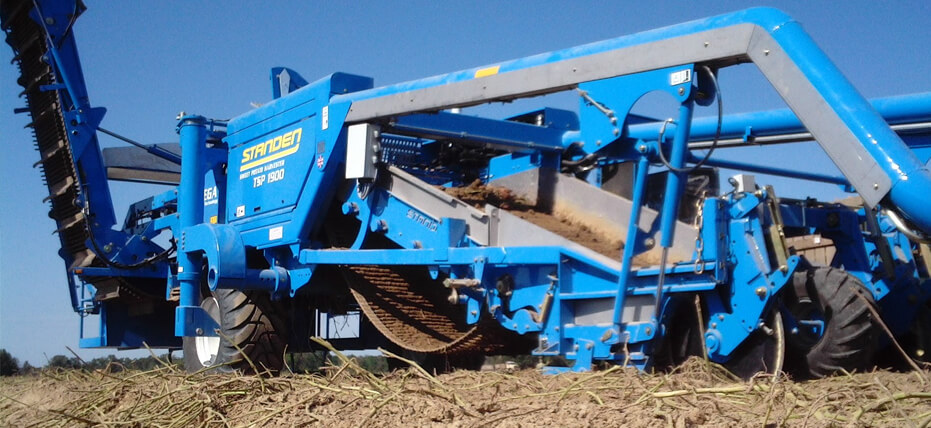Standen Engineering Ltd design and manufacture machinery for the agricultural industry and has very early beginnings, with a rich history to match. They started out in the 1800s as a general blacksmiths, run by Frank Standen of St Ives. In the 1950s, Peter Standen took over the helm and developed the company’s first sugar beet harvester to satisfy the demands of Norfolk’s booming sugar beet industry. Today, Standen are best known for their Standen-Pearson potato-handling equipment. Their mainline products include: bed formers, planters, soil separators, harvesters and tillers.
A new era of design
Standen Engineering was a relatively early adopter of 2D CAD, having used both PC DOGS in the 1980s, later swapping out for AutoCAD. In 2009, Technical Director, Richard Holmes made the decision to invest in SOLIDWORKS 3D design software. “AutoCAD was fine, but it had the same limitations as any 2D system. Now that we have SOLIDWORKS, we couldn’t go back. It’d be like going from AutoCAD to the drawing board.”
Bespoke work and variation on existing machinery is how the company wins many of its sales. There are three designers and all of them use SOLIDWORKS on a daily basis to carry out ongoing product development, respond to customer requests, and reengineer existing equipment. Their approach to product development is an iterative one. Over the last 10 years, the designers at Standen Engineering have re-engineered the entire product line.
Richard has seen the market change in his time at Standen. For customers who are spending upwards of £50,000 for a system, the equipment not only has to do the job but it has to look the part too. In 3D, it is much easier to concentrate on the aesthetics of a design whilst also ensuring it works as it should.
New Product Development
The first new product Standen developed in SOLIDWORKS was their sweet potato harvester (pictured below) for the US market. Potato harvesters are highly specialised pieces of equipment – not only must they be able to recover potatoes from the ground, it must be done in a fashion that does not damage the product. Sweet potatoes grow in a different way to the potatoes we know and love and also need to be handled more delicately. Standen have worked with the sweet potato industry to develop a machine that is suited to the job. Designing the machinery in 3D was a much more efficient process than in AutoCAD. After field prototypes had been tested, further modifications had to be made. Making alterations to designs in 2D is often problematic. “In SOLIDWORKS, you can change one dimension and everything else updates automatically, including drawings. I didn’t realise how many errors would be avoided, but regardless of whether we’re designing from scratch or modifying existing models – everything fits when we go to the assembly line.”

Communicating designs
Communicating the design of this new product to customers was infinitely easier thanks to SOLIDWORKS. Richard uses the 3D PDF functionality in SOLIDWORKS to share designs with people outside of the engineering team. There’s no need for additional software – anyone with an up to date version of Adobe Acrobat Reader can pan, zoom, and rotate around a SOLIDWORKS model. “We were able to provide our sales team with 3D models of the design before it had even been manufactured. As an engineer, it is too easy to assume that everyone can read a 2D drawing. The ability to show clients 3D models and photorealistic renderings wows them and has proven fundamental in selling our designs.”
One of the main benefits that Richard notes is the ease with which drawings can be created. Once they have a completed model, producing drawings takes just a few minutes. Projecting different views of the design is easy, as is the creation of isometric views and section views. The design team even includes images of the 3D model in the corner of their drawings to easily identify them in the workshop. “We couldn’t go back – it was just so time consuming in 2D.”
Technical Director, Richard Holmes has come all the way from the drawing board, through the era of 2D CAD and is now designing in 3D on a daily basis. “I was hesitant at first, concerned that SOLIDWORKS might be too much, but from an engineer’s point of view it is much easier. Speaking with my design team, they all look forward to coming to work – and that’s testament to SOLIDWORKS. Bringing SOLIDWORKS in has been the best decision I have made at Standen Engineering. We knew it was the right thing to do, it was just taking that leap of faith.”
“Innova Systems has offered excellent technical support over the years and we know they are just at the end of the phone if we have any queries. Recently, we had a problem with a design that couldn’t be resolved over the phone. Innova Systems quickly sent out one of their Applications Engineers who worked with us to solve the issue on site.”
There are big projects on the horizon for the team at Standen and Mark Bradford, Managing Director at Innova Systems said: “I can offer my personal assurance that Innova Systems will be there to support Standen Engineering throughout their ongoing product development.”



















